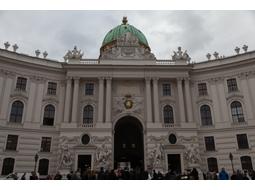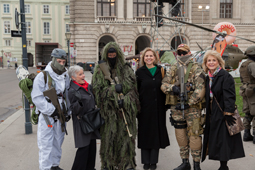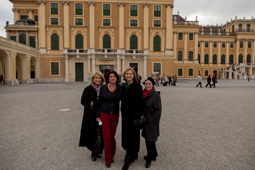Units Overseas Tour: Austria

On October 23, 2014 we flew from Rome to Vienna, Austria. After checking into our hotel, we were greeted by Fay Ann Gauster who escorted us by streetcar to the Huth restaurant for dinner with the Blue Danube Chapter, Ada Miller, Regent. Fay Ann explained that the area in which we were staying is along The Ring, site of the Roman wall which existed in medieval times. Remnants of the wall were removed in the mid-19th century and the wide boulevard was created. This was my first trip to Vienna and it reminded me of Paris. The city is very clean and the buildings are elegant.
Friday morning we walked with Cecilia Dames and Carlotta Rokita to the Hofburg Palace to see the Lipizzaner stallions at the Spanish Riding School, founded in 1565. The school is held in a Baroque hall of the Hofburg Imperial Palace built in 1735. We watched the morning exercises in which the students, wearing white riding pants, brown coats with tails and brown boots, practice with the horses to relaxing Viennese waltzes.
It was fascinating to learn the famous white horses were saved by General Patton as World War II came to an end. I learned that when the Germans surrendered in 1945, Col. Alois Podhajsky, an aristocratic Austrian, was looking for a way to guarantee the safety of the riding school and horses he supervised as the Spanish Riding School had been captured by Lt. Gen. Walton H. Walker's XX Corps. Walker, a protégé of Patton's, requested a performance of its white Lipizzaner stallions especially for the General. As Patton watched, the horses and riders went through the precise, ballet like maneuvers they were famous for. When it was over, Podhajsky halted his horse before Patton and removed his hat in a traditional salute. "In a little Austrian village in a decisive hour two men faced each other," he wrote in his memoir, My Dancing White Horses, the basis for the 1963 Disney film, Miracle of the White Stallions, "the one as triumphant conqueror in a war waged with such bitterness, the other as a member of a defeated nation." He asked Patton for protection for the centuries-old school during the uncertain postwar period and for help in retrieving its breeding herd from Czechoslovakia, where the Germans had sent the horses to a stud farm. Patton replied that he was putting the Spanish Riding School under the special protection of the U.S. Army; he later told Podhajsky he would do what he could about the horses in Czechoslovakia. “Operation Cowboy,” the mission which rescued the horses in Czechoslovakia, is an equally fascinating story.
 The area around the Palace was filled with military equipment and personnel in celebration of National Day, the day on which Austrians celebrate their country’s declaration of permanent neutrality after World War II.
The area around the Palace was filled with military equipment and personnel in celebration of National Day, the day on which Austrians celebrate their country’s declaration of permanent neutrality after World War II.
Carlotta pointed out ancient ruins marking the site of the city’s walls in the center of a round-about. We visited St Michael’s Church, built in 1220. The church has a magnificent silver organ built in 1742 which is considered to be one of the most significant musical instruments in Austria. It was played for the first time in the presence of the Emperor Charles VI. Famous musicians who have performed at St. Michael’s include Joseph Hayden and Wolfgang Amadeus Mozart.
 We continued our walking tour, stepping into St. Stephen’s Cathedral which dates from the 13th century. The Cathedral is the most recognizable Gothic landmark in Vienna with a tower completed in 1433 which rises dramatically almost 450 feet.
We continued our walking tour, stepping into St. Stephen’s Cathedral which dates from the 13th century. The Cathedral is the most recognizable Gothic landmark in Vienna with a tower completed in 1433 which rises dramatically almost 450 feet.
Vienna has excellent public transportation and we rode the Ubahn (metro) with Fay Ann to meet the chapter for lunch at Café Central built in 1876 where I enjoyed a delicious Wiener Schnitzel. However, I quickly learned that my high school German was of little help. When I greeted our server with “Guten Tag” she replied “Grüß Gott”, which means “God’s Greetings.” A lovely greeting indeed!
 That afternoon, Ada and her husband, Scott, drove us a few miles outside of Vienna to tour Schönbrunn Palace. The palace is a former imperial 1,441-room Rococo summer residence occupied by the Habsburg monarchs since the reign of Holy Roman Emperor Maximillian II (1569). The building was devastated by the Turkish siege of Vienna in 1683 and rebuilt as a hunting lodge based on a design by Baroque architect Johann Bernhard Fischer von Erlach, hosting the leading statesmen of Europe. Following the downfall of the monarchy in 1918 the newly founded Austrian Republic became the owner of Schönbrunn Palace and preserved, as a museum, the rooms and chambers. It was at the Palace where six year old Wolfgang Mozart performed in 1762 and where John F. Kennedy and Nikita Khrushchev met in 1961.
That afternoon, Ada and her husband, Scott, drove us a few miles outside of Vienna to tour Schönbrunn Palace. The palace is a former imperial 1,441-room Rococo summer residence occupied by the Habsburg monarchs since the reign of Holy Roman Emperor Maximillian II (1569). The building was devastated by the Turkish siege of Vienna in 1683 and rebuilt as a hunting lodge based on a design by Baroque architect Johann Bernhard Fischer von Erlach, hosting the leading statesmen of Europe. Following the downfall of the monarchy in 1918 the newly founded Austrian Republic became the owner of Schönbrunn Palace and preserved, as a museum, the rooms and chambers. It was at the Palace where six year old Wolfgang Mozart performed in 1762 and where John F. Kennedy and Nikita Khrushchev met in 1961.
Mindy departed on Saturday morning and Virginia and I returned to the Hofburg Palace where were joined by other chapter members for a tour of the Schatzkammer (Royal Treasury). Highlights included the Austrian imperial crown and a cradle given by the city of Paris to Napoleon upon the birth of his son. Other chapter members joined us at a nearby coffeehouse for lunch and I learned that coffee was first brought to Vienna during the Turkish siege of 1683. Coffeehouses abound in Vienna and often tempt diners with luscious pastries.
 The Blue Danube Chapter, organized in 2007, now has 40 members. The chapter meeting was held at the Café Museum on Saturday evening with over 30 members and guests. It was a pleasure to present a certificate to Ada for the chapter’s 100% participation in the President General’s Project and to update the members on some of the activities at National Headquarters.
The Blue Danube Chapter, organized in 2007, now has 40 members. The chapter meeting was held at the Café Museum on Saturday evening with over 30 members and guests. It was a pleasure to present a certificate to Ada for the chapter’s 100% participation in the President General’s Project and to update the members on some of the activities at National Headquarters.
We bid Auf Wiedersehen to our Austrian friends and headed to Germany the next morning.


 Today's DAR
Today's DAR